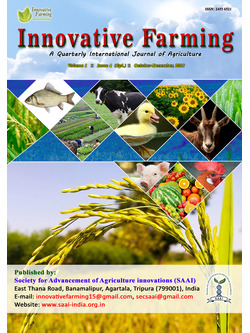
Soil Solarization: An Approach towards Sustainable Agriculture
Vinod Kumar*
Dept. of Vegetable Science, CCS Haryana Agricultural University, Hisar - 125004, India
Ankush
Dept. of Soil Science, CCS Haryana Agricultural University, Hisar - 125004, India
S.K. Tehlan
Dept. of Vegetable Science, CCS Haryana Agricultural University, Hisar - 125004, India
Ankit Kumar
Dept. of Entomology, CCS Haryana Agricultural University, Hisar - 125004, India
Priyanka
Dept. of Agronomy, CCS Haryana Agricultural University, Hisar - 125004, India
DOI: NIL
Keywords: Plastic sheet, Soil borne pathogens, Crop growth, Ecofriendly
Abstract
Soil solarization is an organic approach for managing soil-borne pests using high temperature produced by absorbing radiant energy from the sun. The method involves soil heating by covering it with a clear plastic film (2-4 mil, Note: 1 mil = 0.001 inch or 0.025 mm) for 4 to 6 weeks during summer months of the year when the soil receives the highest amount of direct sunlight. It is an effective tool for managing the population of soil-borne pathogens, weed flora, eggs and larvae of harmful insects. Being non-chemical in nature, it can be a useful eco-friendly option for pest management in organic food production. Increased plant growth and yield of annual and perennial field crops, vegetables and fruit crops usually occur by adopting this technique.
Downloads
not found
Reference
Elmore, C. L. 1997. Soil solarization a nonpesticidal method for controlling diseases, nematodes, and weeds. University of California, Division of Agriculture and Natural Resources Publication, 21377.
Gamliel, A., Austeraweil, M., & Kritzman, M. 2000. Non-chemical approach to soilborne pest management – organic amendments. Crop Protection, 19: 847–853.
Gamliel, A., & Stapleton, J. J. 1993. Effect of chicken or ammonium phosphate and solarization on pathogen control, rhizosphere microorganism and lettuce growth. Plant Diseases, 77: 886–891.
Lodha, S., Sharma, S. K., & Aggarwal, R. K. 1997. Solarization and natural heating of irrigated soil amended with cruciferous residues for improved control of Macrophomina phaseolina. Plant Pathology, 46(2): 186–190.
Pokharel, R., & Hammon, R. 2010. Increased efficacy of biofumigation by soil solarization and integrating with Brassica meal cake and poultry manure to manage soil-borne problem in onion. Report Submitted to EPA, PESP Program, pp. 23.
Pullman, G., DeVay, J., Garber, R., & Weinhold, A. 1981. Soil solarization for the control of Verticillium wilt of cotton and the reduction of soil-borne populations of Verticillium dahliae, Pythium spp., Rhizoctonia solani, and Thielaviopsis basicola. Phytopathology, 71: 954–959.
Ristania, J. B., Pery, K. B., & Lumseden, R. D. 1991. Effect of soil solarization and Gliocladium virans on sclerotia of Sclerotium rolfsii, soil microbiota and the incidence of southern blight of tomato. Phytopathology, 81: 1117–1124.
Sivan, A., & Chet, I. 1993. Integrated control of Fusarium crown rot and root rot of tomato with Trichoderma harzianum in combination with methyl bromide or soil solarization. Crop Protection, 12: 380–386.
